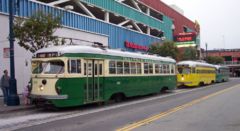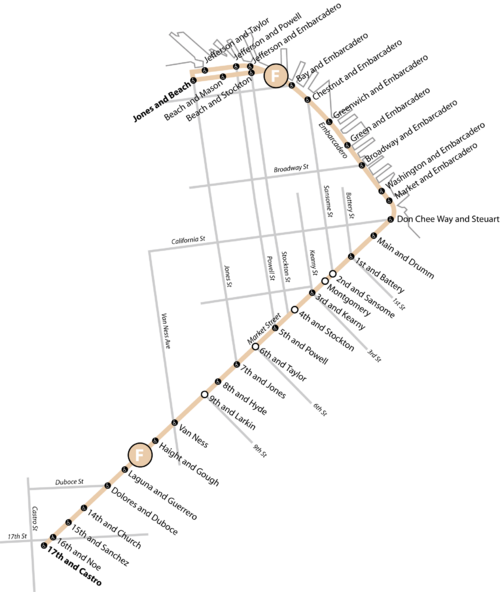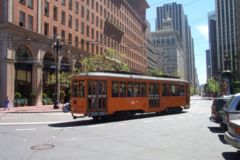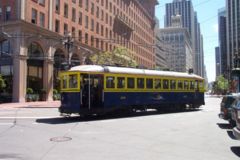F Market
The F Market line is one of several light rail lines in San Francisco, California. Unlike the other LRV lines, the F line is operated as a heritage railway using exclusively historical equipment both from San Francisco's retired fleet as well as from cities around the world. While the F line is operated by the San Francisco Municipal Railway (Muni), that operation is supported by the Market Street Railway, a nonprofit organization of streetcar enthusiasts which raises funds and helps to restore vintage streetcars.
Despite its heritage status, the F Market line is an integral part of Muni's intermodal urban transport network, operating at frequent intervals for 20 hours a day, seven days a week. It carries local commuters and tourists alike, linking residential, business and leisure oriented areas of the city. Unlike the San Francisco cable car system, standard Muni fares are levied.
Contents
History
The F Market line owes its existence to the advent of the San Francisco Historic Trolley Festivals, which began in 1983. These summertime operations of vintage streetcars on Market Street were a joint project of the San Francisco Chamber of Commerce and Muni, originally intended as a one year only substitute attraction for the cable car system, which at that time was closed for reconstruction. The route went from the Transbay Terminal at First and Mission Streets to Market, then up Market to Duboce Avenue. From there, it followed a 'temporary' streetcar detour built in the 1970s to bypass subway construction under Market: Duboce, Church Street, and 17th Street to Castro.
The Trolley Festival proved so successful that it was repeated every year until 1987. In that year preparation began for the introduction of a permanent F line. After that year’s festival finished, Muni replaced the old Market Street tracks with new ones, restoring tracks to upper Market Street and creating a line to Castro again. Different types of vintage streetcars were evaluated to provide the backbone of the F-line fleet, resulting in the decision to use the PCC car, with its San Francisco transit heritage. Fourteen such cars were acquired second-hand from Philadelphia, to add to three of Muni’s own retired double-ended PCCs.
On Labor Day, 1995, the F line opened with a parade of PCC cars, painted to represent some of the two dozen North American cities that this type of streetcar once served. Ridership exceeded expectation, and the need for extra cars resulted in the acquisition of ten Peter Witt style cars just being retired in the Italian city of Milan. These cars were built in the 1920s to a design once common in North American cities.
In March 2000, service on the F line began along a new extension on The Embarcadero to Fisherman's Wharf.[1]
Operation
Route map
Stops
The trolleys operate continuously, reversing direction via loops at the ends of the line. The stations and stops are as follows (transfers to other rail transit are noted):
- Jones and Beach (near Piers 45 and 47, the waterfront end of the Powell/Hyde cable car line, and the San Francisco Maritime Museum)
- Jefferson and Taylor (only when approaching Jones)
- Beach and Mason (only when departing from Jones, near the Waterfront end of the Powell/Mason cable car line))
- Jefferson and Powell (only when approaching Jones)
- Beach and Stockton (only when departing from Jones)
- Jefferson and the Embarcadero (near Pier 39)
- A direct loop connection, from Jefferson and the Embarcadero, to Beach and Stockton, allows cars to be turned short of the Jones and Beach terminal
- Bay and the Embarcadero
- Chestnut and the Embarcadero
- Greenwich and the Embarcadero (near the Filbert steps)
- Green and the Embarcadero(near the Fog City Diner)
- Broadway and the Embarcadero
- Washington and the Embarcadero
- Ferry Terminal/Market and the Embarcadero
- Don Chee Way and Steuart
- At this point, the line leaves the Embarcadero and turns southwest, passing briefly through a private right-of-way that has been designated as Don Chee Way before coming onto Market Street. Here also is a turning loop capable of turning cars coming off either the Embarcadero or Market Street, and a non-revenue connection to the lines of the Muni Metro N Judah line further east along the Embarcadero. In 2006, the nonprofit Market Street Railway opened a museum and gift store celebrating San Francisco's historic streetcars and cable cars adjacent to the Steuart Street stop. Wonderful photos and exhibits are on display and admission is free.
- Main and Drumm (near the Embarcadero end of the California Street cable car line, and the BART/Muni Metro Embarcadero Station)
- 1st and Battery
- 2nd and Sansome
- Montgomery (near the BART/Muni Metro Montgomery Street Station)
- 3rd and Kearny
- 4th and Stockton
- 5th and Powell (near the Market Street end of the Powell/Hyde and Powell/Mason cable car lines, and the BART/Muni Metro Powell Street Station)
- 6th and Taylor
- 7th and Jones
- 8th and Hyde (near the BART/Muni Metro Civic Center Station)
- 9th and Larkin
- Van Ness (U.S. Route 101; near the Muni Metro Van Ness Station)
- Haight and Gough
- Laguna and Guerrero
- Dolores and Duboce
- 14th and Church (near the Muni Metro Church Street Station)
- 15th and Sanchez
- 16th and Noe
- 17th and Castro (near the Muni Metro Castro Street Station station)
Cars
At any given time the bulk of the cars operating the line will be a mixture of PCC and Peter Witt cars, although other more unusual or historic cars can be seen in service on occasion. Included in the equipment are:
- PCC streetcars from San Francisco, Philadelphia, and Newark, many painted in the color schemes of some past PCC streetcar operators including:
- Baltimore Transit Company, in Baltimore
- Chicago Transit Authority, in Chicago
- Cincinnati Street Railway Company, in Cincinnati
- Illinois Terminal Railroad, in St. Louis
- Kansas City Public Service Company, in Kansas City, MO
- Los Angeles Railway, in Los Angeles
- Louisville, in Kentucky
- Massachusetts Bay Transportation Authority, in Boston
- Muni, in San Francisco
- Pacific Electric Railway, in Los Angeles
- Philadelphia Suburban Transportation Company, in Philadelphia
- Philadelphia Transportation Company, in Philadelphia
- Other cars from:
- Blackpool Tramway, in Blackpool, England
- Hamburger Hochbahn AG, in Hamburg, Germany
- Hankai Electric Rail Service Company, in Osaka, Japan
- Johnstown Traction Company, in Johnstown, Pennsylvania
- Kobe City Railways, in Kobe, Japan
- Market Street Railway Company, in San Francisco
- Melbourne & Metropolitan Tramways Board, in Melbourne, Australia
- Moscow, in Russia
- Muni, in San Francisco
- Porto, in Portugal
- STIB/MIVB, in Brussels, Belgium
- St. Charles Avenue Streetcar, in New Orleans
(Not all cars are currently in service)
Future extensions
There are plans to further extend heritage streetcar operation in San Francisco:
- From the foot of Market Street to the Caltrain depot at Fourth and King Streets, using the existing non-revenue connection with existing Muni Metro tracks on the Embarcadero at Folsom Street, three blocks south of Market, then sharing those tracks with N Judah line. Low-level platforms with wheelchair ramps have been installed on the jointly-used track with the light rail line south of Folsom Street. This extension is currently operable with double-end vintage equipment; installation of a turning loop at the south end of the line would allow all vintage equipment to be used. The Muni Short Range Transit Plan (2006-2025) currently projects opening of this extension in 2007, to be designated the "E Embarcadero line" and extending north along the F-line tracks on The Embarcadero to share its Fisherman's Wharf terminal.
- From the vicinity of the existing Jones Street terminal, westward alongside the San Francisco Maritime Museum and Aquatic Park, and then running through an historic (1914) but disused single-track railroad tunnel to Fort Mason. A technical feasibility study, under the aegis of the National Park Service and Muni, was completed in December 2004. An Environmental Impact Statement (EIS) for the extension, again led by the National Park Service, commenced in May 2006. This extension could be operated either as a part of the F-line or the E-line.
Trivia
- The cars of the F Market line contain typical advertising from their places and times of origin.
- Except for the height of certain platforms, F Market line cars are fully compatible with the rest of the Muni Metro system. Indeed, the cars can be privately chartered and are operated all over the system.
- The F Market line operates a car dedicated to Herb Caen, the noted columnist for the San Francisco Chronicle perhaps most famous for coining the phrase Baghdad by the Bay to describe The City. The car contains wood paneling and is decorated with many quotes from Caen.
- In the Clint Eastwood film Dirty Harry, Harry Callahan runs through the railroad tunnel under Fort Mason, emerging at the eastern portal facing Aquatic Park. This is the tunnel which may be used in one of the future extensions of the historic streetcar line(s).
References
- ↑ Market Street Railway (2005). A brief history of the F-line. Retrieved March 20, 2006.
External links
- Market Street Railway website
- Muni Metro and San Francisco rail map (195KB PDF)
- F Market route information from the SF Muni Map Project
- Transit Rider Photos
- Maps and news about the extension to Fort Mason
| San Francisco Municipal Railway | |
| Muni Metro | J Church • K Ingleside • L Taraval • M Ocean View • N Judah • S Castro Shuttle • T Third Street |
| Other Muni services | Cable cars • F Market streetcar • List of all Muni bus and rail lines |
| Muni Metro stations | Embarcadero • Montgomery • Powell • Civic Center • Van Ness • Church • Castro • Forest Hill • West Portal |
| Muni Metro system features | Market Street Subway • Twin Peaks Tunnel • Sunset Tunnel |
| Current projects | Third Street Light Rail Project • Central Subway • E Embarcadero streetcar |
| Connecting buses | AC Transit • Golden Gate Transit • SamTrans |
| Connecting rail services | Bay Area Rapid Transit • Caltrain |
| Other information | Rescue Muni • Key System |




